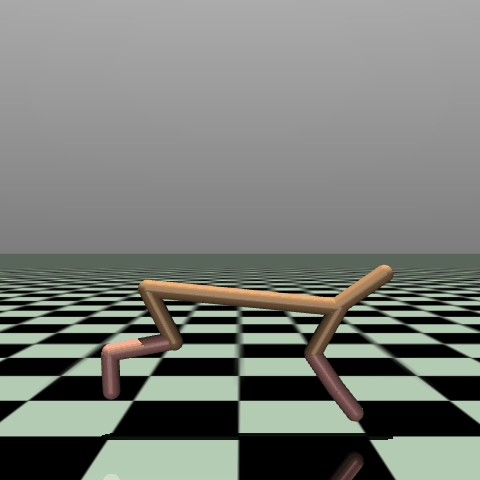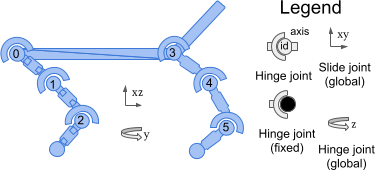Half Cheetah¶

This environment is part of the Mujoco environments which contains general information about the environment.
Action Space |
|
Observation Space |
|
import |
|
Description¶
This environment is based on the work of P. Wawrzyński in “A Cat-Like Robot Real-Time Learning to Run”. The HalfCheetah is a 2-dimensional robot consisting of 9 body parts and 8 joints connecting them (including two paws). The goal is to apply torque to the joints to make the cheetah run forward (right) as fast as possible, with a positive reward based on the distance moved forward and a negative reward for moving backward. The cheetah’s torso and head are fixed, and torque can only be applied to the other 6 joints over the front and back thighs (which connect to the torso), the shins (which connect to the thighs), and the feet (which connect to the shins).
Action Space¶

The action space is a Box(-1, 1, (6,), float32). An action represents the torques applied at the hinge joints.
Num |
Action |
Control Min |
Control Max |
Name (in corresponding XML file) |
Joint |
Type (Unit) |
|---|---|---|---|---|---|---|
0 |
Torque applied on the back thigh rotor |
-1 |
1 |
bthigh |
hinge |
torque (N m) |
1 |
Torque applied on the back shin rotor |
-1 |
1 |
bshin |
hinge |
torque (N m) |
2 |
Torque applied on the back foot rotor |
-1 |
1 |
bfoot |
hinge |
torque (N m) |
3 |
Torque applied on the front thigh rotor |
-1 |
1 |
fthigh |
hinge |
torque (N m) |
4 |
Torque applied on the front shin rotor |
-1 |
1 |
fshin |
hinge |
torque (N m) |
5 |
Torque applied on the front foot rotor |
-1 |
1 |
ffoot |
hinge |
torque (N m) |
Observation Space¶
The observation space consists of the following parts (in order):
qpos (8 elements by default): Position values of the robot’s body parts.
qvel (9 elements): The velocities of these individual body parts (their derivatives).
By default, the observation does not include the robot’s x-coordinate (rootx).
This can be included by passing exclude_current_positions_from_observation=False during construction.
In this case, the observation space will be a Box(-Inf, Inf, (18,), float64), where the first observation element is the x-coordinate of the robot.
Regardless of whether exclude_current_positions_from_observation is set to True or False, the x- and y-coordinates are returned in info with the keys "x_position" and "y_position", respectively.
By default, however, the observation space is a Box(-Inf, Inf, (17,), float64) where the elements are as follows:
Num |
Observation |
Min |
Max |
Name (in corresponding XML file) |
Joint |
Type (Unit) |
|---|---|---|---|---|---|---|
0 |
z-coordinate of the front tip |
-Inf |
Inf |
rootz |
slide |
position (m) |
1 |
angle of the front tip |
-Inf |
Inf |
rooty |
hinge |
angle (rad) |
2 |
angle of the back thigh |
-Inf |
Inf |
bthigh |
hinge |
angle (rad) |
3 |
angle of the back shin |
-Inf |
Inf |
bshin |
hinge |
angle (rad) |
4 |
angle of the back foot |
-Inf |
Inf |
bfoot |
hinge |
angle (rad) |
5 |
angle of the front thigh |
-Inf |
Inf |
fthigh |
hinge |
angle (rad) |
6 |
angle of the front shin |
-Inf |
Inf |
fshin |
hinge |
angle (rad) |
7 |
angle of the front foot |
-Inf |
Inf |
ffoot |
hinge |
angle (rad) |
8 |
velocity of the x-coordinate of front tip |
-Inf |
Inf |
rootx |
slide |
velocity (m/s) |
9 |
velocity of the z-coordinate of front tip |
-Inf |
Inf |
rootz |
slide |
velocity (m/s) |
10 |
angular velocity of the front tip |
-Inf |
Inf |
rooty |
hinge |
angular velocity (rad/s) |
11 |
angular velocity of the back thigh |
-Inf |
Inf |
bthigh |
hinge |
angular velocity (rad/s) |
12 |
angular velocity of the back shin |
-Inf |
Inf |
bshin |
hinge |
angular velocity (rad/s) |
13 |
angular velocity of the back foot |
-Inf |
Inf |
bfoot |
hinge |
angular velocity (rad/s) |
14 |
angular velocity of the front thigh |
-Inf |
Inf |
fthigh |
hinge |
angular velocity (rad/s) |
15 |
angular velocity of the front shin |
-Inf |
Inf |
fshin |
hinge |
angular velocity (rad/s) |
16 |
angular velocity of the front foot |
-Inf |
Inf |
ffoot |
hinge |
angular velocity (rad/s) |
excluded |
x-coordinate of the front tip |
-Inf |
Inf |
rootx |
slide |
position (m) |
Rewards¶
The total reward is: reward = forward_reward - ctrl_cost.
forward_reward: A reward for moving forward, this reward would be positive if the Half Cheetah moves forward (in the positive \(x\) direction / in the right direction). \(w_{forward} \times \frac{dx}{dt}\), where \(dx\) is the displacement of the “tip” (\(x_{after-action} - x_{before-action}\)), \(dt\) is the time between actions, which depends on the
frame_skipparameter (default is \(5\)), andframetimewhich is \(0.01\) - so the default is \(dt = 5 \times 0.01 = 0.05\), \(w_{forward}\) is theforward_reward_weight(default is \(1\)).ctrl_cost: A negative reward to penalize the Half Cheetah for taking actions that are too large. \(w_{control} \times \|action\|_2^2\), where \(w_{control}\) is
ctrl_cost_weight(default is \(0.1\)).
info contains the individual reward terms.
Starting State¶
The initial position state is \(\mathcal{U}_{[-reset\_noise\_scale \times I_{9}, reset\_noise\_scale \times I_{9}]}\). The initial velocity state is \(\mathcal{N}(0_{9}, reset\_noise\_scale^2 \times I_{9})\).
where \(\mathcal{N}\) is the multivariate normal distribution and \(\mathcal{U}\) is the multivariate uniform continuous distribution.
Episode End¶
Termination¶
The Half Cheetah never terminates.
Truncation¶
The default duration of an episode is 1000 timesteps.
Arguments¶
HalfCheetah provides a range of parameters to modify the observation space, reward function, initial state, and termination condition.
These parameters can be applied during gymnasium.make in the following way:
import gymnasium as gym
env = gym.make('HalfCheetah-v5', ctrl_cost_weight=0.1, ....)
Parameter |
Type |
Default |
Description |
|---|---|---|---|
|
str |
|
Path to a MuJoCo model |
|
float |
|
Weight for forward_reward term (see |
|
float |
|
Weight for ctrl_cost weight (see |
|
float |
|
Scale of random perturbations of initial position and velocity (see |
|
bool |
|
Whether or not to omit the x-coordinate from observations. Excluding the position can serve as an inductive bias to induce position-agnostic behavior in policies (see |
Version History¶
v5:
Minimum
mujocoversion is now 2.3.3.Added support for fully custom/third party
mujocomodels using thexml_fileargument (previously only a few changes could be made to the existing models).Added
default_camera_configargument, a dictionary for setting themj_cameraproperties, mainly useful for custom environments.Added
env.observation_structure, a dictionary for specifying the observation space compose (e.g.qpos,qvel), useful for building tooling and wrappers for the MuJoCo environments.Return a non-empty
infowithreset(), previously an empty dictionary was returned, the new keys are the same state information asstep().Added
frame_skipargument, used to configure thedt(duration ofstep()), default varies by environment check environment documentation pages.Restored the
xml_fileargument (was removed inv4).Renamed
info["reward_run"]toinfo["reward_forward"]to be consistent with the other environments.
v4: All MuJoCo environments now use the MuJoCo bindings in mujoco >= 2.1.3.
v3: Support for
gymnasium.makekwargs such asxml_file,ctrl_cost_weight,reset_noise_scale, etc. rgb rendering comes from tracking camera (so agent does not run away from screen).v2: All continuous control environments now use mujoco-py >= 1.50.
v1: max_time_steps raised to 1000 for robot based tasks. Added reward_threshold to environments.
v0: Initial versions release.


